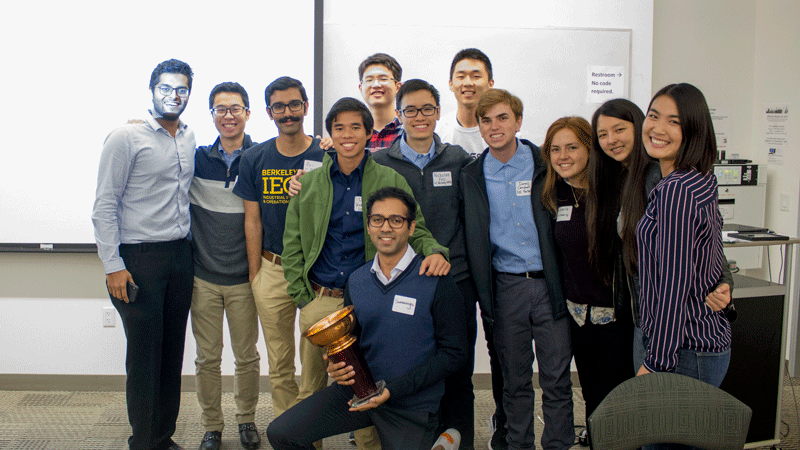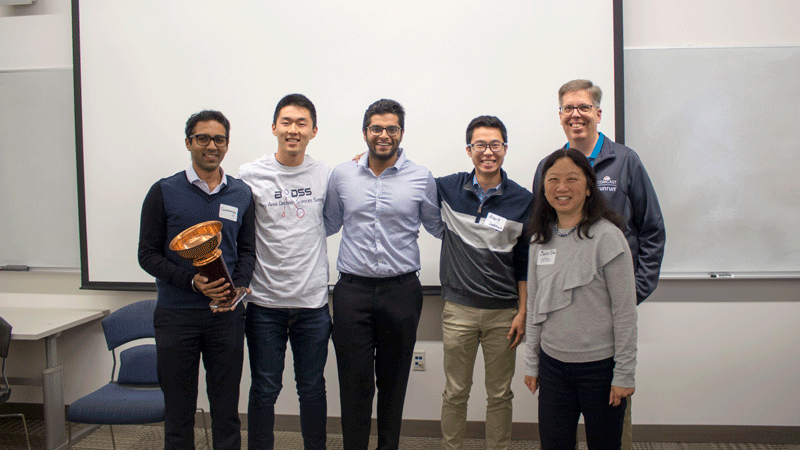BADSS Summit Helps Grow Bay Area Decision Sciences Community

Sometimes you can learn more by collaborating with others outside the classroom than you can learn inside of it.
That was what San Francisco State University (SFSU) College of Business dean, Linda Oubre, told students to kick off the first ever Bay Area Decision Sciences Summit (BADSS), an event organized by undergraduate students and faculty from the University of California at Berkeley, San Jose State University (SJSU), Santa Clara University (SCU), and SFSU.
The goal of the event was to help build the community of students and faculty working in decision sciences and related fields in the Bay Area. The summit featured a case competition, alumni panel, and keynote presentation from IEOR alum Nirmal Govind, head of the studio production & streaming data science group at Netflix.
In the case competition, students had the opportunity to form teams and use analytical tools to work on the problem of solar adoption. The competition was sponsored by Sunrun, a solar energy and panel company based in San Francisco. Sunrun provided students with data related to solar adoption and U.S. demographics, and challenged students to use the data to find the best opportunities for finding new customers.
From the data, students investigated many questions that may help Sunrun know where to go next for their next customer. Which states have the most sun and highest potential energy production? Do factors like age, dwelling type, and income matter? How do the incentives and laws of specific regions affect solar coverage?
The winning team was from Berkeley and made up of IEOR students Wesley Jin, Sumaanyu Maheshwari, Albert Loekman, and Tanay Gupta. In their analysis, the Berkeley students decided to investigate which factors were correlated with solar coverage in each zip code, i.e. which features of a community have so far been associated with the most solar adoption? They found that the factors that mattered most are income, blue-collar percentage, median home value, median age, divorced percentage, and percent moved since 2000 (with the theory that new homeowners are more likely to invest in new solar panels).
BADSS summit organizers: Stella Bao, UC Berkeley; Theresa Roeder SFSU and Berkeley; Max Bush, SFSU; Hannah Lane, SFSU; Meggan Chu, San Jose State University; Tiffany Ta, Santa Clara University “I’m so proud of the students for making this event happen, and especially of all participants in the case competition,” said Theresa Roeder, SFSU professor, Berkeley IEOR lecturer, and advisor for the project. “It takes a lot to go through such a big dataset in so little time to find some results — and even more to stand up in front of a group to present and then put yourself through the grilling by the judges! Many thanks to Professor Yano and Professor Schruben for coming out and supporting our students. I’m looking forward to next year’s event!”
After lunch, students had the opportunity to interact with data scientists and analysts to get their questions answered about what it is like to work in industry. What does a typical day look like? What kinds of skills are most important? How can I get my resume noticed? Panelists were alumni from SFSU and included Anthony Ratto, senior application support analyst at Sunrun, Stephen Ruane, data integration admin at Cisco Meraki, and Matthew Low, risk and business data analyst at the San Francisco Public Utilities Commission.
The day concluded with a keynote from Nirmal Govind (Berkeley IEOR M.S. ‘99), who currently leads data science for studio production and streaming at Netflix, a big job for a company that is now one of the largest production studios in the world and is also responsible for one of every three bits transferred online today.
Govind went through some of the data problems at Netflix. What is the ideal catalog of movies and television shows that Netflix should keep on hand? How much is the content worth? How can Netflix predict demand for content in advance? The Data Science team at Netflix analyzes the entire process of producing content, including what should be sourced, which servers around the world should host which content, and how the Netflix app itself recommends movies and television shows that you are most likely to want to watch.
One particularly impactful issue that Govind’s team works on is the digital supply chain of producing original content through Netflix’s studio. Given a simple show or movie idea (e.g. “Batman meets Stranger Things”), how can Netflix estimate the budget? Once a show is approved, how can the production supply chain of scripts, shoots, and schedules be optimized? For example, shooting some scenes out of order can mean big savings for movies and shows that film at multiple locations.
Besides the leadership from Professor Roeder and other faculty, the event would not have happened without the hard work of students at participating schools, including Stella Bao from Berkeley, Hannah Lane and Max Bush from SFSU, Tiffany Ta from Santa Clara University, and Meggan Chu from San Jose State.
“I am so honored to help Professor Roeder’s vision come to life, because this event was so fun and natural to our field of study. I hope this becomes a tradition among Bay Area universities where we continue to connect with like-focused students and apply our knowledge to highly interesting case studies. Thank you to all those who came and participated. I hope to see this event grow and that the trophy is ‘personalized’ for many years to come! Congratulations!” said Hannah, who in addition to being the emcee for the event, created the first BADSS trophy and designed the logo.
“I was very happy and excited to see students from different universities in Bay Area come together to connect, share, and learn from each other’s experiences,” added Stella, president of the Berkeley chapter of the Institute of Industrial and Systems Engineers. “Special thanks to Hannah Lane, Prof. Roeder, and everyone in the committee organizing and staffing this event. Our hard work really paid off! Also, I am super proud of all our case competition teams to come out! I would like to congratulate our case competition winners, you guys really deserves the golden trophy! Keep up the good work Bears!”
